Finds after 1970
On 14 April 1970m fisherman K. J. Bout found parts of an altar to Nehalennia in his nets while fishing near Colijnsplaat. Focused searches in 1970, 1971, and 1974 resulted in the find of about 240 altars and statues, votive stones and remains of a Roman building. These are now stored and displayed in the National Museum of Antiquities in Leiden. These were found in the Schaar of Colijnsplaat, a fairway in the Eastern Scheldt, where the temple of Nehalennia once stood.
The names of the persons who dedicated the statues and altars show that they were merchants from Italy, Cologne, Trier and Britain. They traded in salt, fish sauce, and textiles. Other wares included ceramics from the area around the Rhine, terracotta figurines from Cologne and Trier, and wine from Southern France and the Mosel. One inscription found translates to: "Before Nehalennia, Marcus Exingius Agricola, citizen of Trier, salt merchant in Cologne, has fulfilled his promise, willing and with reason." The majority of the votive offerings were donated by merchants to beseech the goddess for safe passage to Britannia.
In the period after the year 300, the temple disappeared into the Schaar of Colijnsplaat, near the settlement of Ganventa. Since 1999, a group of Flemish amateur archaeologists belonging to the Landelijke Werkgroep Archeologie Onder Water (National Work Group of Underwater Archaeology) has worked to map the bottom of the sea, around the location where the temple disappeared beneath the waves. A replica of the temple was built in Colijnsplaat in 2004.
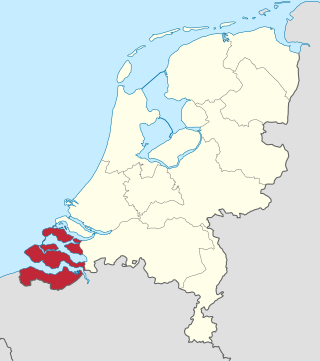
Zeeland is the westernmost and least populous province of the Netherlands. The province, located in the southwest of the country, borders North Brabant to the east, South Holland to the north, as well as the country of Belgium to the south and west. It consists of a number of islands and peninsulas and a strip bordering the Flemish provinces of East and West Flanders. Its capital is Middelburg with a population of 48,544 as of November 2019, although the largest municipality in Zeeland is Terneuzen. Zeeland has two seaports: Vlissingen and Terneuzen. Its area is 2,934 square kilometres (1,130 sq mi), of which 1,151 square kilometres (440 sq mi) is water; it has a population of 383,689.

Walcheren is a region and former island in the Dutch province of Zeeland at the mouth of the Scheldt estuary. It lies between the Eastern Scheldt in the north and the Western Scheldt in the south and is roughly the shape of a rhombus. The two sides facing the North Sea consist of dunes and the rest of its coastline is made up of dykes. Middelburg, the provincial capital, lies at Walcheren's centre. Vlissingen, 9 kilometres (5.6 mi) to the south, is the main harbour and the third municipality is Veere.

Coventina was a Romano-British goddess of wells and springs. She is known from multiple inscriptions at one site in Northumberland, England, an area surrounding a wellspring near Carrawburgh on Hadrian's Wall. It is possible that other inscriptions, two from Hispania and one from Narbonensis, refer to Coventina, but this is disputed.
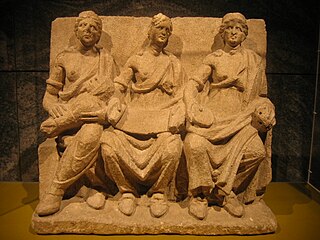
The Matres and Matronae were female deities venerated in Northwestern Europe, of whom relics are found dating from the first to the fifth century AD. They are depicted on votive offerings and altars that bear images of goddesses, depicted almost entirely in groups of three, that feature inscriptions and were venerated in regions of Germania, Eastern Gaul, and Northern Italy that were occupied by the Roman army from the first to the fifth century.

Noord-Beveland is a municipality and region in the southwestern Netherlands and a former island, now part of the Walcheren-Zuid-Beveland-Noord-Beveland peninsula. Noord-Beveland is enclosed by the Oosterschelde estuary to the north, and the former straits, now combined lake, of Veerse Meer and Zandkreek to the south. As part of the Delta Works, dams have connected Noord-Beveland to Walcheren and Zuid-Beveland.

Nehalennia is a goddess of unclear origin, perhaps Germanic or Celtic. She is attested on and depicted upon numerous votive altars discovered around what is now the province of Zeeland, the Netherlands, where the Schelde River flowed into the North Sea. Worship of Nehalennia dates back at least to the 2nd century BC, and veneration of the goddess continued to flourish in northern Europe in the 2nd and 3rd centuries AD.

The concept of liberty has frequently been represented by personifications, often loosely shown as a female classical goddess. Examples include Marianne, the national personification of the French Republic and its values of Liberté, Égalité, Fraternité, the female Liberty portrayed on United States coins for well over a century, and many others. These descend from images on ancient Roman coins of the Roman goddess Libertas and from various developments from the Renaissance onwards. The Dutch Maiden was among the first, re-introducing the cap of liberty on a liberty pole featured in many types of image, though not using the Phrygian cap style that became conventional. The 1886 Statue of Liberty by Frédéric Auguste Bartholdi is a well-known example in art, a gift from France to the United States.

In the localised Celtic polytheism practised in Great Britain, Sulis was a deity worshiped at the thermal spring of Bath. She was worshiped by the Romano-British as Sulis Minerva, whose votive objects and inscribed lead tablets suggest that she was conceived of both as a nourishing, life-giving mother goddess and as an effective agent of curses wished by her votaries.
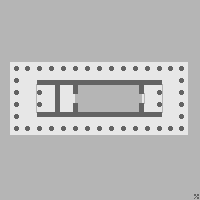
A cella or naos is the inner chamber of an ancient Greek or Roman temple in classical antiquity. Its enclosure within walls has given rise to extended meanings, of a hermit's or monk's cell, and since the 17th century, of a biological cell in plants or animals.

Walpurga or Walburga, also spelled Valderburg or Guibor, was an Anglo-Saxon missionary to the Frankish Empire. She was canonized on 1 May c. 870 by Pope Adrian II. Saint Walpurgis Night is the name for the eve of her feast day in the Medieval period, which coincided with May Day; her feast is no longer celebrated on that day, but the name is still used for May Eve.

The Heraion of Samos was a large sanctuary to the goddess Hera, on the island of Samos, Greece, 6 km southwest of the ancient city of Samos. It was located in the low, marshy basin of the Imbrasos river, near where it enters the sea. The late Archaic temple in the sanctuary was the first of the gigantic free-standing Ionic temples, but its predecessors at this site reached back to the Geometric Period of the 8th century BC, or earlier. As a testimony to the mercantile and naval power of Samos during Archaic Greece, and its exceptional architecture, the site of temple's ruins, with its sole standing column, was designated a UNESCO World Heritage Site, along with the nearby archeological site Pythagoreion in 1992.

Kouklia is a village in the Paphos District, about 16 kilometres (9.9 mi) east from the city of Paphos on the Mediterranean island of Cyprus. The village is built in the area of "Palaepaphos", mythical birthplace of Aphrodite, Greek goddess of love and beauty, which became the centre for her worship in the ancient world. Because of its ancient religious significance and architecture, Kouklia was inscribed on the UNESCO World Heritage List along with Kato Paphos in 1980.

Colijnsplaat is a village in the Province of Zeeland, the Netherlands It is a part of the Municipality of Noord-Beveland, and lies about 20 km (12 mi) northeast of Middelburg.
The mythology of the modern-day Netherlands, Belgium and Luxembourg has its roots in the mythologies of pre-Christian cultures, predating the region's Christianization under the influence of the Franks in the Early Middle Ages. At the time of the Roman Empire and in the Early Middle Ages, some of the resident peoples of the Low Countries' included:

Zemen is a town in Pernik Province, western Bulgaria. Located near the Pchelina Reservoir on the banks of the Struma River, it is the administrative centre of Zemen Municipality.
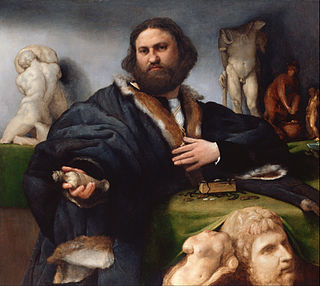
The Reynst Collection, probably the most extensive Dutch 17th-century collection of art and artefacts, was owned by the Dutch merchants Gerrit Reynst and Jan Reynst. The collection was put on display in their house at the sign of Hope on the Keizersgracht in Amsterdam. It consisted of over 200 Italian paintings and over 300 sculptures, most of them ancient Roman. There were other antiquities: ten sepulchral monuments, five votive reliefs, nine cinerary urns, "Etruscan" vases, and Christian objects, as well as engraved gems. The collection was dispersed in the 1660s and 1670s, after both brothers had died, and Gerrit's widow sold parts to various buyers.

The Temple of Artemis or Artemision, also known as the Temple of Diana, was a Greek temple dedicated to an ancient, local form of the goddess Artemis. It was located in Ephesus. By 401 AD it had been ruined or destroyed. Only foundations and fragments of the last temple remain at the site.

Fortuna Redux was a form of the goddess Fortuna in the Roman Empire who oversaw a return, as from a long or perilous journey. Her attributes were Fortuna's typical cornucopia, with her specific function represented by a rudder or steering oar sometimes in conjunction with a globe.

A Romano-Celtic temple or fanum is a sub-class of Roman temple found in the north-western Celtic provinces of the Roman Empire. They were the main places of worship in Gallo-Roman religion. Romano-Celtic temples differ from classical Roman temples, and evidence shows they had much continuity with earlier Celtic temples. Many were built on earlier sacred sites of the Celtic religion.
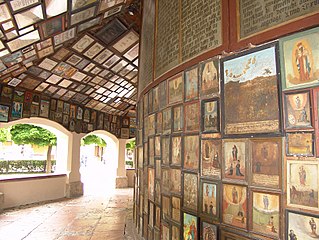
A votive offering or votive deposit is one or more objects displayed or deposited, without the intention of recovery or use, in a sacred place for religious purposes. Such items are a feature of modern and ancient societies and are generally made in order to gain favor with supernatural forces.



















